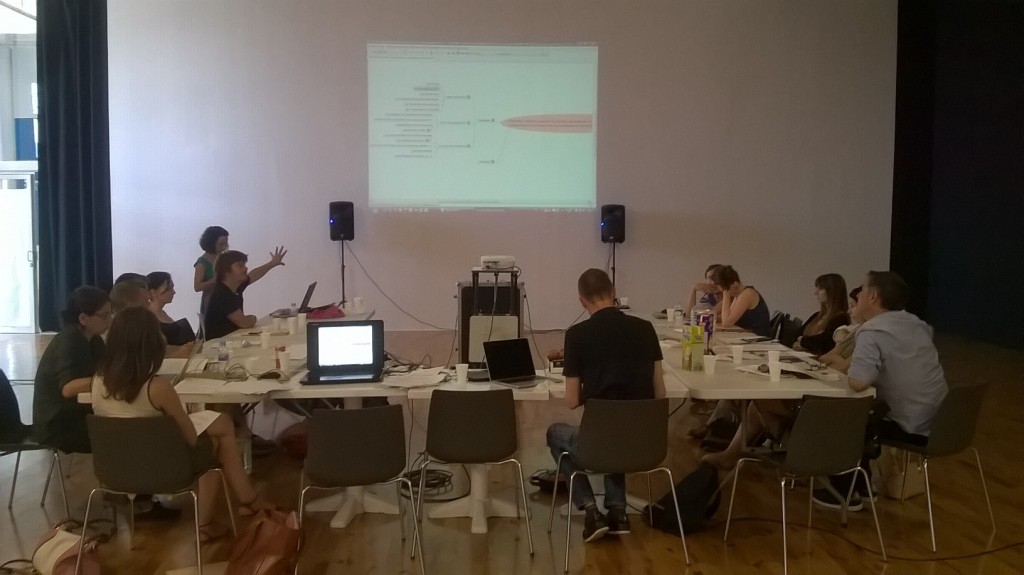
Tools
Mindmap
Over the past years, we have been interested in the question of the evaluation of the impact produced by an artistic action directed towards various publics, mostly inside at first, since it was from prison that this thought became absolutely necessary. We had to be able to name what was taking place, escape the unique field of the sensible, to share what the inmates were going through emotionally within experiences of artistic creation. We also had to clearly identify the impacts and their transferable qualities. The objective was not to turn all of the participants intro professionals of the artistic and cultural sector. But the social abilities that they developed within the apparatuses of collaborative creation are elements that can shift in both the professional and private field.
It was also important to think evaluation in a different manner than through constraint, and seek tools and approaches capable of developing a better dialogue between the different partner, and professional worlds that co-exist in terms of questions of cultural projects but that often misunderstand each other: the of artistic cultural, educational, social, and judiciary worlds.
We also had to enrich ourselves of the vision of researchers, to borrow methodologies, usually the ones of research-action in which we developed a reflection and its application, at the same time, whilst being confronted to the permanent real and to the implication of the different actors in terms of the production of the analysis.
Mind-mapping is a tool that gives a non-reductive vision, and lets appear in a non-hierarchical manner, links between the different dimensions of the projects and their impacts. It is not just a tool; it is the approach that gives the possibility to build it. It is important to start from the interviews led with the participants. This method forces to establish an close following, that relies on times which have been observed to put into words what is happening, and give the participants the space to speak, accepting that the impacts that had been imagined, might not be those that are felt in the real.
The mind map is a new access, which is clearer, in terms of what is at stake in an artistic experience and in terms of the educational process.
Depuis plusieurs années, nous nous sommes intéressés à la question de l’évaluation des impacts produits par une action artistique auprès de différents publics, principalement au-dedans au départ, puisque c’est depuis la prison que cette réflexion est devenue plus que nécessaire. En effet, il s’agissait de pouvoir nommer ce qui se produisait, sortir du champ unique du sensible, pour expliciter et partager ce que les personnes détenues traversaient émotionnellement dans des expériences de création artistique. Il fallait aussi plus clairement identifier les impacts et leur caractère transférable. Il ne s’agit pas de faire de tous les participants des professionnels de l’art et de la culture. Mais les compétences sociales développées dans des dispositifs de création collaborative sont des éléments qui peuvent être déplacés, dans le champ professionnel en général, et dans le champ privé.
Il fallait aussi penser l’évaluation autrement que sous le mode de la contrainte, et chercher des outils et des approches capables d’élaborer un meilleur dialogue entre les différents partenaires, les mondes professionnels qui cohabitent dans la question des projets culturels mais qui souvent se comprennent mal : le monde de l’art et de la culture, celui de l’éducation, du social, de la justice.
Il fallait aussi s’enrichir du regard des chercheurs, pour emprunter des méthodologies, principalement celles de la recherche action dans laquelle on élabore une pensée et sa mise en application, en même temps, avec un souci de frottement au réel permanent et une implication des différents acteurs dans la production de l’analyse.
Le mind mapping est un outil qui permet une vision non réductrice, en faisant apparaître de manière non hiérarchique les liens entre les différentes dimensions des projets et leurs impacts. Et surtout il ne s’agit pas que d’un outil, c’est l’approche qui permet de le construire. Il s’agit de partir d’entretiens menés avec les personnes participantes. Cette méthode oblige à mettre en place un accompagnement approfondi, qui s’appuie sur des temps repérés pour verbaliser, chercher des mots pour dire ce qui se passe, et donc donner la parole aux participants, en acceptant que les impacts imaginés ne soient pas forcément les impacts ressentis dans le réel finalement.
La mind map, est un nouvel accès, plus clair, à ce qu’une expérience artistique met en jeu en termes de processus pédagogique
